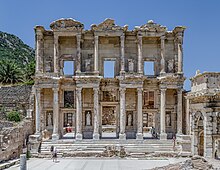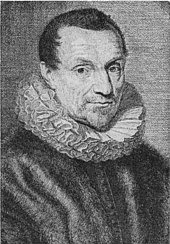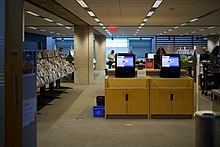History of libraries
[14] Persia at the time of the Achaemenid Empire (550–330 BC) was home to some outstanding libraries that were serving two main functions: keeping the records of administrative documents (e.g., transactions, governmental orders, and budget allocation within and between the Satrapies and the central ruling State)[15] and collection of resources on different sets of principles e.g. medical science, astronomy, history, geometry, and philosophy.
The cuneiform texts cover various contents from records of sales, taxes, payments, treasury details and food storage to remarkable social, artistic and philosophical aspects of an ordinary life in the Empire.
A part of this impressive library archive is now kept in Iran while a major proportion is still in the hands of the Chicago Oriental Institute as a long-term loan for the purpose of studying, analyzing, and translating.
[clarification needed][18] Less historically tested claims have also reported a sizeable building in Isfahan, Jey, named Sarouyeh, which was being used by Iran's ancient dynasties to store collections of precious books and manuscripts.
[25][further explanation needed] Private or personal libraries made up of written books (as opposed to the state or institutional records kept in archives) appeared in classical Greece in the 5th century BC.
After his military victory in Illyria, Pollio felt he had enough fame and fortune to create what Julius Caesar had sought for a long time: a public library to increase the prestige of Rome and rival the one in Alexandria.
The Bibliotheca Pacis was built along the traditional model and had two large halls with rooms for Greek and Latin libraries containing the works of Galen and Lucius Aelius.
[36][37] Wood-block printing, facilitated the large-scale reproduction of classic Buddhist texts which were avidly collected in many private libraries that flourished during the Tang dynasty (618–906 AD).
Enriching the library resources, the academy constantly was sending ambassadors to widespread geographical regions e.g. China, Rome and India to inscribe the manuscripts, codices, and books; translate them to Pahlavi from diverse languages e.g. Sanskrit, Greek and Syriac and bring them back to the centre.
[18] During the Late Antiquity and Middle Ages periods, there was no Rome of the kind that ruled the Mediterranean for centuries and spawned the culture that produced twenty-eight public libraries in the urbs Roma.
Cassiodorus, minister to Theodoric, established a monastery at Vivarium in the toe of Italy (modern Calabria) with a library where he attempted to bring Greek learning to Latin readers and preserve texts both sacred and secular for future generations.
"libraries (royal, public, specialized, private) had become common and bookmen (authors, translators, copiers, illuminators, librarians, booksellers' collectors) from all classes and sections of society, of all nationalities and ethnic backgrounds, vied with each other in the production and distribution of books.
Major libraries often employed translators and copyists in large numbers, in order to render into Arabic the bulk of the available Persian, Greek, Roman and Sanskrit non-fiction and the classics of literature.
[70] At the time even local rulers demonstrated their passion for knowledge by designing and developing public libraries that could stand out in both aesthetic features and creating a space that maximizes the patrons' comfort.
[82] The original Deed manuscript, being kept in National Museum of Tabriz, is now a registered UNESCO World Heritage document[83] They were many other sizable libraries in major Islamic cities, e.g. Basrah, Damascus, Isfahan, Tous, Baghdad, Shoush, Mosul and Shiraz.
To achieve this early form of printing the Chinese would push soft paper onto the stone, apply ink to the back of the sheet, resulting in a black background with white letters.
[90] This hand-copying was often accomplished by travelling monks who made the treks to the sources of knowledge and illumination they sought for learning or to copy the manuscripts held by other monasteries for their own monastic libraries.
[106] Trigge's library held over 350 books, and his inclusion of both Catholic and Protestant resources is considered unique for the time, since religious conflicts during the Reformation years were common.
[87]: 116 Given the large cost associated with the creation of the codex it should come as little surprise that books would be seen as a prize of both pecuniary and scholastic wealth, enough that a Bavarian noble named Maximilian I Duke of Bavaria sent the captured contents of the Palatine Library of Heidelberg to the Vatican as a trophy to the Pope Gregory XV.
[112][87]: 118–119 [113] On the other side of the conflict, King Gustavus Adolphus of Sweden specifically targeted Jesuit schools and seminaries and had wagon loads of loot (seized books and manuscripts) returned to the libraries of his home.
[87]: 118 Large volumes of books changed hands during the Thirty Years' War and eventually found their way across Europe where new libraries sprang up to house these redistributed treasures.
Even though the subscription libraries were often founded by reading societies, committees, elected by the subscribers, chose books for the collection that were general, rather than aimed at a particular religious, political or professional group.
[149] The first exhibition galleries and reading room for scholars opened on 15 January 1759,[150] and in 1757, King George II granted it the right to a copy of every book published in the country, thereby ensuring that the Museum's library would expand indefinitely.
The collections increased steadily by purchase and gift to the outbreak of the French Revolution, at which time it was in grave danger of partial or total destruction, but owing to the activities of Antoine-Augustin Renouard and Joseph Van Praet it suffered no injury.
[162] In 1835, and against government opposition, James Silk Buckingham, MP for Sheffield and a supporter of the temperance movement, was able to secure the Chair of the Select Committee which would examine "the extent, causes, and consequences of the prevailing vice of intoxication among the labouring classes of the United Kingdom" and propose solutions.
Francis Place, a campaigner for the working class, agreed that "the establishment of parish libraries and district reading rooms, and popular lectures on subjects both entertaining and instructive to the community might draw off a number of those who now frequent public houses for the sole enjoyment they afford".
The identity of the evolving American culture incorporated a strong belief that independent thought, democratic government, and religious morality relied heavily on access to information, and the ability to read.
[178] Philanthropists and businessmen, including John Passmore Edwards, Henry Tate and Andrew Carnegie, helped to increase the number of public libraries from the late 19th century.
[199] The years of apartheid began with the Natal Indian Congress, founded by Gandhi, which called upon the Durban City Council to end the restriction of non-Europeans by opening the library to all sections of the community.
The Municipal Library he built 1958–62 for the German city of Wolfsburg features a great central room for which he used a series of specially designed skylights to bring in natural light, even though all the walls are covered with books.




























